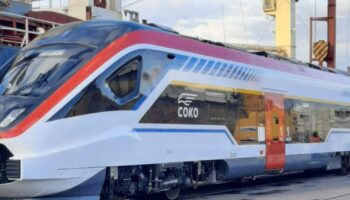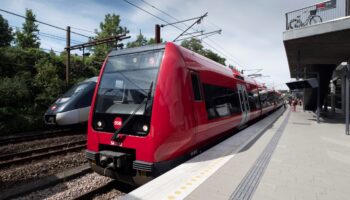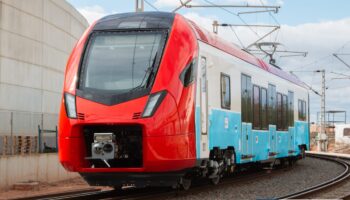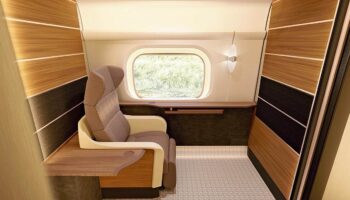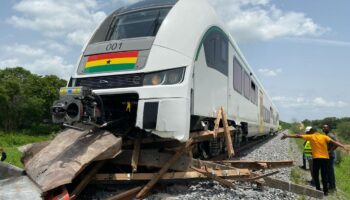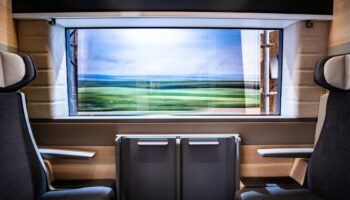UK: In a test run in March, a prototype train travelled 138 km from Long Marston to Honeybourne on battery power alone and without recharging. In doing so, an upgraded metro train has set a new autonomous running record for the country’s rail network. The project curator, the passenger operator Great Western Railway (GWR), reports that the prototype train made several stops along the way, accelerating to speeds of up to 97 km/h and overcoming elevation changes of up to 200 m. However, the results of another overhauled train – a diesel hybrid vehicle run by the Welsh operator Transport for Wales (TfW) – do not inspire confidence in replicating such projects.
GWR’s BEMU today
In February, a three-car Class 230 train used only 45% of the charge to travel 113 km autonomously to a depot in Reading, UK. According to GWR engineers, such long journeys show that a single charge would be sufficient for the train to travel more than 193 km. The previous UK record was set by a Stadler Class 777 BEMU, which travelled 135 km in a test in 2022.
Test runs of the Class 230 train. Source: GWR/YouTube
Pilot trials of the train and its fast-charging system, FastCharge, began on 18 March on the 4 km Greenford–West Ealing line in west London. The train will charge the batteries at West Ealing station in 3.5 m, which is expected to be enough time to run a standard timetable throughout the day. On return to the depot, the batteries should be at least 30% charged, with full charging completed overnight. Throughout the year, it will be possible to test the performance of the train’s batteries and traction system in different weather conditions, using the heating system in winter and the air conditioning in summer.
The trials will take place between regular passenger services, with no restrictions on the latter. At the same time, GWR said that passengers will be allowed on some of the BEMU runs.
Technical characteristics of BEMU
The Class 230 train is the result of an extensive overhaul of the London Underground’s D78 cars, manufactured between 1978 and 1981 by MCCW, a British company acquired by Alstom in 1989. The overhaul was carried out by Vivarail, which went bankrupt at the end of 2022. In February 2023, GWR acquired some of its assets, including intellectual rights, one train, and equipment for the development of batteries and FastCharge technology. Additionally, GWR hired nine former Vivarail employees.
 The D78 metro train. Source: Wikipedia
The D78 metro train. Source: Wikipedia
The GWR-owned train consists of three cars, of which two are head motor cars and one is an intermediate car. The overhaul has strengthened the driver’s cab, renovated the interior, added seats across the car, and provided air-proof gangways. Each motor car is now fitted with three German Hoppecke lithium-ion traction batteries with a total capacity of 504 kW⋅h, converters and traction and charging control systems. The bogies with LT118 DC traction motors by Brush Traction, which was acquired by Wabtec in 2021, remain unaltered, as does the design speed of 97 km/h.
Third rail rails, located between the tracks, enable charging through retractable carbon ceramic collector shoes, capable of withstanding up to 1,200 A. With a power output of 2,000 kW when charging two motor cars simultaneously, the traction batteries can be replenished in just a few minutes. To prevent the external catenary from overloading during fast charging, the charging station is equipped with batteries, so the input current does not exceed 63 A.
 The FastCharge third rail at the West Ealing station. Source: LRB
The FastCharge third rail at the West Ealing station. Source: LRB
 Fast charging from a third rail. Source: Ben Broomfield/X
Fast charging from a third rail. Source: Ben Broomfield/X
According to GWR, the FastCharge system is completely safe as the contact rail only energises when the train is directly above it. The technology enables rapid installation, taking only a few hours with minimal traffic disruption to install a contact rail and a charging station power equipment in a standard enclosure.
Outlook
On the one hand, BEMUs with an autonomous range of over 100 km can serve non-electrified lines with low passenger traffic. GWR has simulated Class 230 operation on several branch lines in the Thames Valley and estimates the reduction of CO2 emissions following conversion to battery traction by over 1,700 t annually.
The operator’s experts predict that in the long term, the technology will eventually replace diesel trains on more than 80 UK lines spanning over 3,000 km. This aligns with the British railway’s plans to transition to emission-free traction by 2040 and the government’s goal of achieving net-zero carbon emissions by 2050.
 Assessed branch lines in the Thames Valley for Class 230 trains (enlarge). Source: GWR
Assessed branch lines in the Thames Valley for Class 230 trains (enlarge). Source: GWR
GWR asserts that its technology offers several benefits, such as cost-effectiveness and rapid installation of charging stations, in comparison to electrification. Furthermore, it enables preserving picturesque views in regions with low passenger traffic, as such trains require no overhead electric lines.
On the other hand, the hybrid project based on Vivarail technologies has identified some reliability risks.
Other battery and hybrid Vivarail trains
The Class 230 battery trains were selected to serve a commuter line in Philadelphia, USA, with low passenger traffic, as planned in the late 2010s. In 2022, a two-car train was delivered to the country for testing, but the project development was halted due to Vivarail’s bankruptcy.
TfW has made significant progress. The company operates five three-car Class 230 hybrid trains on the 43 km Wrexham–Bidston line. Each central car has four 145 kW diesel engines, and each head car is equipped with four lithium-ion batteries with a total capacity of 400 kW⋅h. The batteries store energy during regeneration, saving fuel and ensuring an operational range of up to 80 km.
 The hybrid Class 230 train at the Chester station. Source: Stephen Widdowson/flickr
The hybrid Class 230 train at the Chester station. Source: Stephen Widdowson/flickr
The launch of the hybrid cars, originally scheduled for 2019, was delayed multiple times due to technical and organisational issues until April 2023. From the first day of operation, breakdowns on the new trains occurred regularly resulting in delays and cancellations. Last summer, engine filters were clogged with pollen, and batteries overheated. Then TfW announced having developed a plan to address the issues and improve the reliability of Class 230.
But the issues weren’t resolved. According to On Time Trains, a train-tracking service, only 9% of journeys in autumn 2023 were on time, while 21% were delayed by more than 10 m and 10% were cancelled. Nevertheless, TfW added the third train to the line since December 2023, reducing intervals from 1 h to 45 m, and if the technical issues with the Class 230 trains are not resolved, the company will replace some of them with Class 197 diesel trains.










